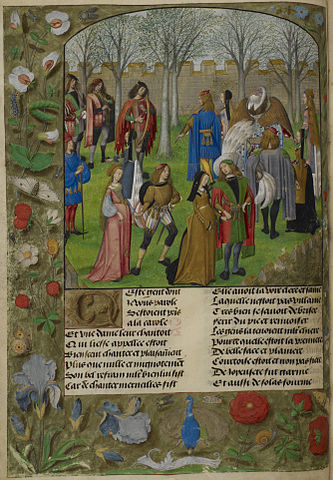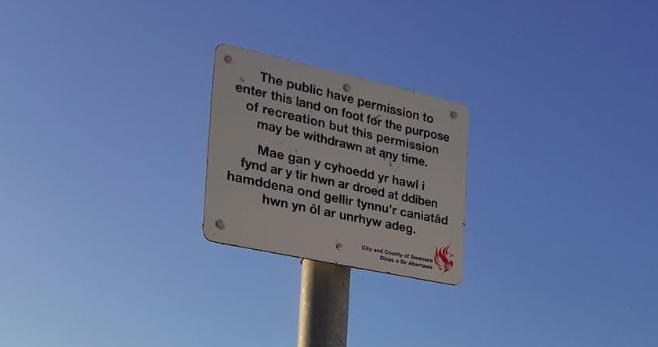by Maria Zygogianni, Swansea University
On April 25th, Lambeth Council closed Brockwell Park for the day after approximately 3000 people visited the park the day before, ignoring guidelines for social distancing. Their message was made clear in a warning tweet: if residents don’t comply, they will be kicked out of the park.

This tweet would not have been out of place in a medieval romance. The medieval world was no stranger to enclosed natural spaces with strict rules about access and behaviour. From Adam and Eve’s transgression, dooming humanity to a life in exile from the Garden of Eden, to secular medieval literature, fascinated with narratives of forbidden enclosed gardens, through the early modern controversies of the Enclosures Act, British culture keeps repeating the story of control, punitive action and ownership of the natural world.
In the anonymous poem The Isle of Ladies (late 15th century), the forbidden garden is an entire island, protected not only by the sea but also by a glass wall that surrounds it. Only women inhabit it, mostly young and beautiful ladies, loyal to their queen. An ancient rule of the island forbids any men from staying, as the dreamer-narrator, transported there mid-reverie, quickly finds out:
The ton is this: our ordinaunce, / Whiche is of longe continuaunce,/ Woll not, sothely we you tell,/ That no mane here amonge us dwell;/ Wherefore ye mot nedes retorne. (l.243-7)
[The one [rule] is this: our order/ which is ancient/ desires, as we truly tell you,/ that no man may dwell here among us;/ Therefore you must return.]
The ladies that warn the dreamer that he must leave are worried; their queen is returning soon, and she will not want to find a man there. Yet, when she returns, a new lady and a knight accompany her. The queen has travelled to a different island, in order to obtain 3 magic golden apples, which can restore life and health and give longevity. There, she found the new lady, who turns out to be the dreamer’s beloved, already in possession of the apples. The knight, who fell in love with the Queen on setting eyes on her, begged her to be with him and almost died when she denied returning his love. The two women brought the knight on the Queen’s boat, revived him with one of the apples and all together returned to the Isle of Ladies.
This rather long poem continues to tell a story of coercion rather than love. The knight persists in his love for the Queen, which she politely refuses but continues to care for his wellbeing. The God of Love wages war on the island and, upon winning, forces the Queen to marry the knight.
The knight then returns to his homeland in order to get his ‘companye’ and prepare for the wedding. After failing to return by the appointed time, he finds most of the ladies either dead or dying. His delay had compromised the honour of the Queen, who had placed her trust in an unreliable lover, and as the poem implies, the only honourable fate for a disgraced woman is death. By means of a magic herb, however, the company is revived and the wedding takes place with much celebration.

London, BL Harley MS 4425, f.14v (CC0 0.1)
Enclosed gardens are closely linked with femininity in medieval imagination and culture, as is illustrated by the famous allegorical dream vision the Le Roman de la Rose or Romance of the Rose about a courtier attempting to woo his lady.
In Isle of Ladies, ownership of the island-garden quite clearly equals ownership of the ladies that inhabit it. Ignoring their customs and rules, the God of Love’s conquest of the island, gives him control of the Queen. In fact, during the wedding celebrations, the Queen and her company of ladies all merrily mingle with the Knight and his entourage. She has apparently forgotten her previous unwillingness to engage with him and has completely given up on a life in all-female company.
The fragile glass wall makes the garden permeable—the ‘courtship’ between the Queen and the Knight takes the form of a siege, similar to the courtship strategy followed by the Lover in The Romance of the Rose. A symbol for a woman’s resistance against seduction, the glass wall of the island offers only illusory protection. Where The Romance of the Rose offers a misogynistic explanation of women’s feeble defences because of their moral weakness, the women of The Isle of Ladies fight to the death in defence of their honour, leaving the reader unsatisfied with the poem’s ‘happy ending’.
The unnamed lady of Marie de France’s Guigemar also inhabits an idyllic garden by the sea. Her elderly husband only allows her to go outside in the garden, accompanied by just one lady, in true social distancing fashion. Enclosed by the house and wall on one side and the sea in the other, her garden seems impenetrable, until the noble, young, wounded Guigemar is transported there by means of a magic ship. The lady cures him and they fall in love, only to be discovered by her husband who forces Guigemar out of the garden. Before he leaves, the lady gives him a shirt with a knot on the sleeve and he ties a knot in her belt that no one else can untie. They agree that they will only love somebody who will be able to untie these knots.
Back in his homeland, Guigemar faces pressure to marry but refuses unless the bride can untie the knot. Meanwhile, the magic ship reappears in the garden and takes the lady to the court of Lord Meriaduc, who falls in love with her. The knot in her belt prevents him from raping her, so he asks all knights and noble men, including Guigemar to try and untie it. The two lovers meet again: after a case of mistaken identity, they recognise each other because of the knots. Guigemar wins the war against evil Meriaduc, he marries the still unnamed lady and they presumably live happily ever after.
The garden in Guigemar is also similar to one in Chaucer’s Merchant’s Tale, functions, which is more like a prison than a space for pleasure. Intensifying the link between female body and the land, the enclosed garden protects the women from the intrusive male gaze, or rather reserves her only for the gaze of her husband. Without her garden surroundings, she becomes completely unrecognisable.
In a surprising statement, Guigemar doubts the lady he re-encounters is the one he loves, since all women resemble each other:
Is this my sweet friend, my hope, my heart, my life, my dear lady who loves me? Whence is she come ? Who brought her hither? Now verily I am thinking nonsense, for I know well that it cannot be she — women are much alike. (Guigemar)
However another enclosure functions as the mark of her true identity: the knot in her belt that keeps her body intact and safe from Meriaduc’s rape attempt, allowing Guigemar alone access to her body.
Escaping the garden in Guigemar brings danger but also a reunion of the two lovers.
Both Marie de France’s lai and the anonymous dream-vision, The Isle of Ladies, make it clear that in literary medieval pleasure gardens, women are not allowed ownership of their space and bodies: the women of The Isle of Ladies need to surrender both their land and themselves to the Knight and the God of Love; the lady in Guigemar abandons her prison-garden to be imprisoned again in Meriaduc’s court and then, safely and possibly happily, enclosed in marriage to Guigemar himself.
The gardens presented in medieval romance are, of course, mostly private, owned by nobles. As the Romance of the Rose suggest, they are not open to all—allegorical figures of Old Age, Poverty, and Disease, among others, decorate the outer walls of the garden of the God of Love, while only young, idle, rich and generous people are admitted. Romance gardenscapes present an idyllic environment that conceals underlying violence and exclusion.
Ultimately, as readers we can ask more of these texts: are enclosed gardens safe? Who controls access to them? When and why is access denied? What power dynamics are at play between the excluded and those allowed in?

The coronavirus epidemic with its renewed focus on access in public space and the dangers of shared environment has revealed the degree to which parks and natural spaces are still subject to the same tensions. These questions help us navigate discourses of access and control of green spaces, whether these spaces are the allegorical enclosed gardens of the medieval romance, or the public parks of 21st century London, or Swansea.
